Water Pollution and Health Impacts
VerifiedAdded on 2020/06/06
|8
|2671
|99
AI Summary
This assignment delves into the detrimental effects of water pollution on human health. It examines various sources of contamination, such as fecal matter, industrial waste, and agricultural runoff, highlighting their impact on water quality. The focus is on understanding the health risks associated with microbial contamination, heavy metal poisoning, and pesticide exposure through contaminated water sources. The assignment utilizes a collection of books, journal articles, and online resources to provide a comprehensive analysis of this crucial environmental and public health issue.
Contribute Materials
Your contribution can guide someone’s learning journey. Share your
documents today.
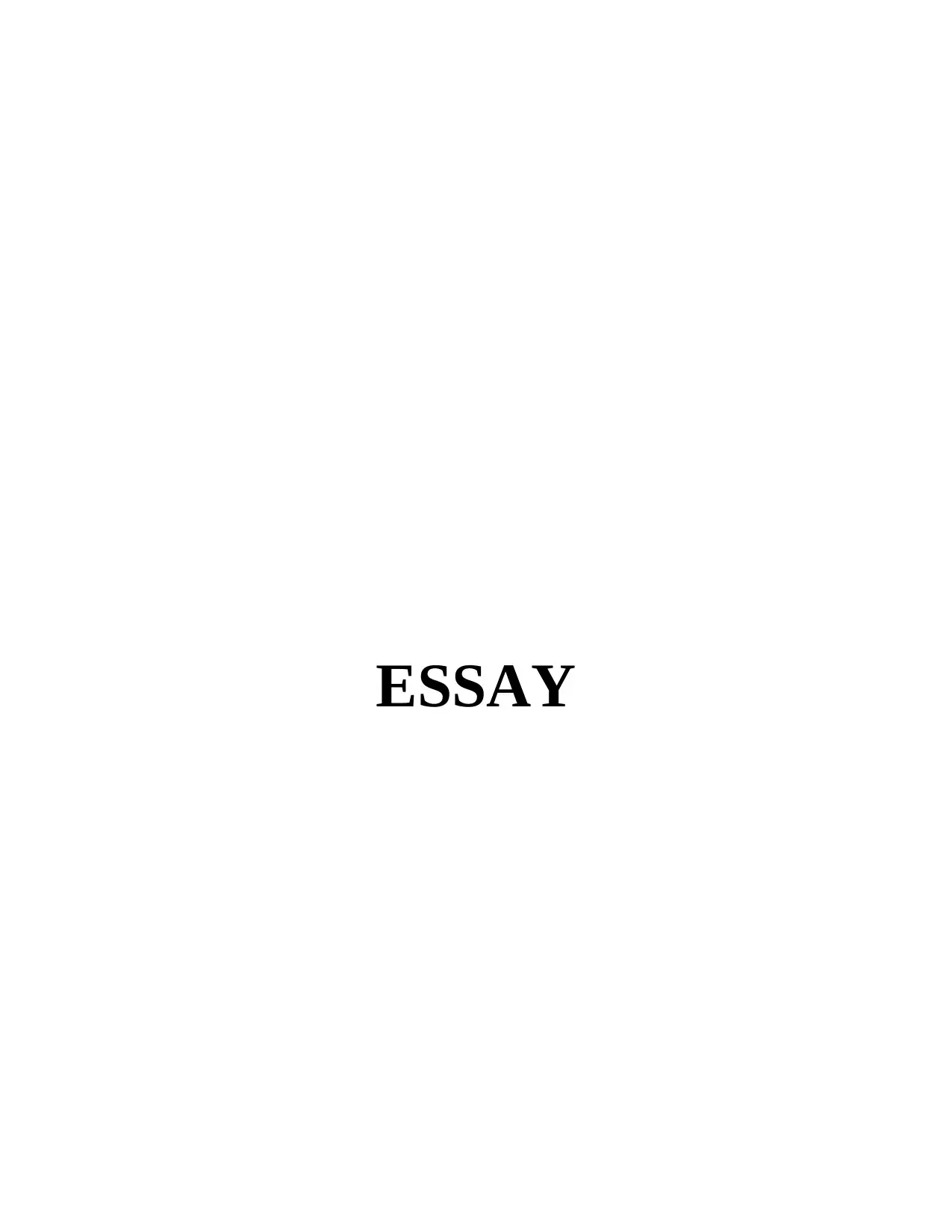
ESSAY
Secure Best Marks with AI Grader
Need help grading? Try our AI Grader for instant feedback on your assignments.
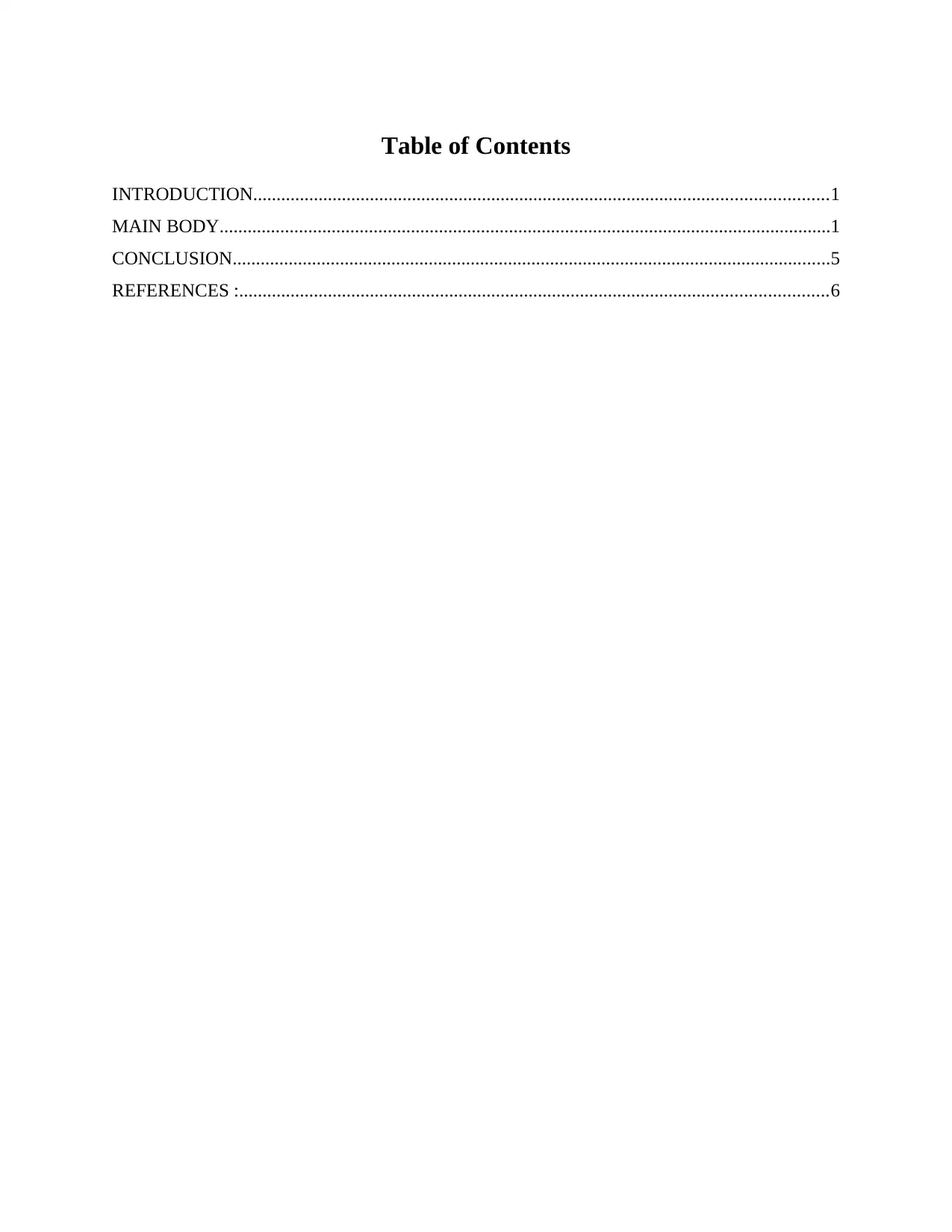
Table of Contents
INTRODUCTION...........................................................................................................................1
MAIN BODY...................................................................................................................................1
CONCLUSION................................................................................................................................5
REFERENCES :..............................................................................................................................6
INTRODUCTION...........................................................................................................................1
MAIN BODY...................................................................................................................................1
CONCLUSION................................................................................................................................5
REFERENCES :..............................................................................................................................6
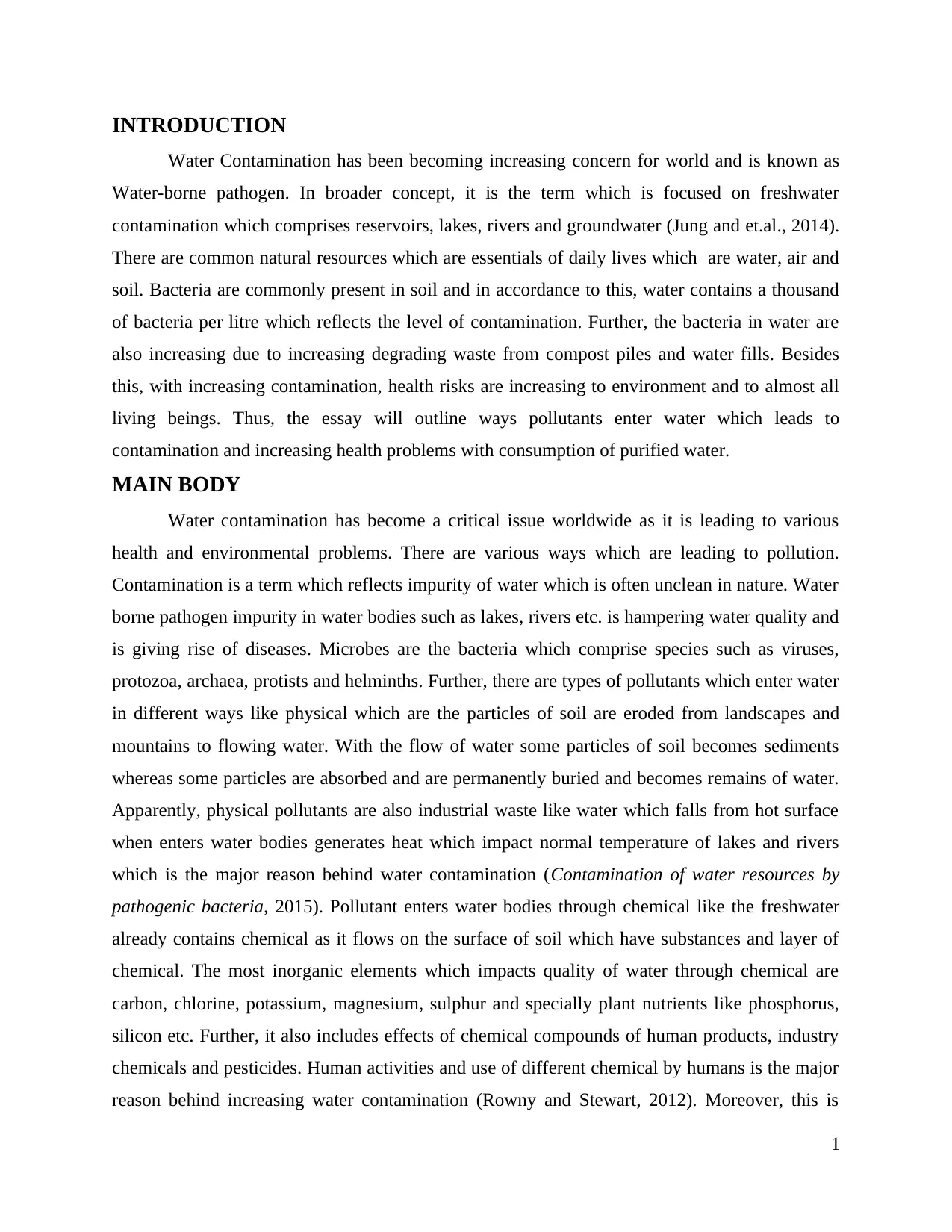
INTRODUCTION
Water Contamination has been becoming increasing concern for world and is known as
Water-borne pathogen. In broader concept, it is the term which is focused on freshwater
contamination which comprises reservoirs, lakes, rivers and groundwater (Jung and et.al., 2014).
There are common natural resources which are essentials of daily lives which are water, air and
soil. Bacteria are commonly present in soil and in accordance to this, water contains a thousand
of bacteria per litre which reflects the level of contamination. Further, the bacteria in water are
also increasing due to increasing degrading waste from compost piles and water fills. Besides
this, with increasing contamination, health risks are increasing to environment and to almost all
living beings. Thus, the essay will outline ways pollutants enter water which leads to
contamination and increasing health problems with consumption of purified water.
MAIN BODY
Water contamination has become a critical issue worldwide as it is leading to various
health and environmental problems. There are various ways which are leading to pollution.
Contamination is a term which reflects impurity of water which is often unclean in nature. Water
borne pathogen impurity in water bodies such as lakes, rivers etc. is hampering water quality and
is giving rise of diseases. Microbes are the bacteria which comprise species such as viruses,
protozoa, archaea, protists and helminths. Further, there are types of pollutants which enter water
in different ways like physical which are the particles of soil are eroded from landscapes and
mountains to flowing water. With the flow of water some particles of soil becomes sediments
whereas some particles are absorbed and are permanently buried and becomes remains of water.
Apparently, physical pollutants are also industrial waste like water which falls from hot surface
when enters water bodies generates heat which impact normal temperature of lakes and rivers
which is the major reason behind water contamination (Contamination of water resources by
pathogenic bacteria, 2015). Pollutant enters water bodies through chemical like the freshwater
already contains chemical as it flows on the surface of soil which have substances and layer of
chemical. The most inorganic elements which impacts quality of water through chemical are
carbon, chlorine, potassium, magnesium, sulphur and specially plant nutrients like phosphorus,
silicon etc. Further, it also includes effects of chemical compounds of human products, industry
chemicals and pesticides. Human activities and use of different chemical by humans is the major
reason behind increasing water contamination (Rowny and Stewart, 2012). Moreover, this is
1
Water Contamination has been becoming increasing concern for world and is known as
Water-borne pathogen. In broader concept, it is the term which is focused on freshwater
contamination which comprises reservoirs, lakes, rivers and groundwater (Jung and et.al., 2014).
There are common natural resources which are essentials of daily lives which are water, air and
soil. Bacteria are commonly present in soil and in accordance to this, water contains a thousand
of bacteria per litre which reflects the level of contamination. Further, the bacteria in water are
also increasing due to increasing degrading waste from compost piles and water fills. Besides
this, with increasing contamination, health risks are increasing to environment and to almost all
living beings. Thus, the essay will outline ways pollutants enter water which leads to
contamination and increasing health problems with consumption of purified water.
MAIN BODY
Water contamination has become a critical issue worldwide as it is leading to various
health and environmental problems. There are various ways which are leading to pollution.
Contamination is a term which reflects impurity of water which is often unclean in nature. Water
borne pathogen impurity in water bodies such as lakes, rivers etc. is hampering water quality and
is giving rise of diseases. Microbes are the bacteria which comprise species such as viruses,
protozoa, archaea, protists and helminths. Further, there are types of pollutants which enter water
in different ways like physical which are the particles of soil are eroded from landscapes and
mountains to flowing water. With the flow of water some particles of soil becomes sediments
whereas some particles are absorbed and are permanently buried and becomes remains of water.
Apparently, physical pollutants are also industrial waste like water which falls from hot surface
when enters water bodies generates heat which impact normal temperature of lakes and rivers
which is the major reason behind water contamination (Contamination of water resources by
pathogenic bacteria, 2015). Pollutant enters water bodies through chemical like the freshwater
already contains chemical as it flows on the surface of soil which have substances and layer of
chemical. The most inorganic elements which impacts quality of water through chemical are
carbon, chlorine, potassium, magnesium, sulphur and specially plant nutrients like phosphorus,
silicon etc. Further, it also includes effects of chemical compounds of human products, industry
chemicals and pesticides. Human activities and use of different chemical by humans is the major
reason behind increasing water contamination (Rowny and Stewart, 2012). Moreover, this is
1

increasing because many plans and animals die and decay in water bodies and the decomposition
of dead leads to bacterial grow. Increasing algae and plant under water bodies enables increasing
decaying activities which limits the supply of oxygen.
Nevertheless, increasing human activities are leading to waste which is collected and
discharged waterside and is also selected in sewage and piped to sewage treatment is finally
discharged to water surface. The waste which is kept near water bodies settle down in water at
time of heavy rainfall. Therefore, lack of drainage system and waste disposal facilities in town is
the major cause of contamination which is leading various health problems such as, diarrhoea,
gastrointestinal illness. Digestion of human body is completely based on safe drinking water and
due to water contamination, hardly no person is getting pure water to consume which is the most
critical problem. Increasing impurities in water has given rise to various water purifiers but on
the hand the contamination is so strong and the hardness of water is hampering human health
across the globe. Developing countries like Africa are the major victims of health problems
which are due to water contamination (Microbial Contamination of Drinking Water and Human
Health from Community Water Systems, 2015). For instance, there are farmers who have high
quality coffee beans but do not have safe water due to which the quality of premium quality
beans are getting destroyed. To manage livelihood and seek for safe drinking water, the farmers
sell coffee beans in return of which the individuals earns water for all. Similarly, contaminated
water is the major cause of illness, nausea, cramps and vomiting. Not every person can get safe
drinking water by implementing use of technologies of purifying water (Bain and et.al., 2014).
Increasing health problems for the people who are struggle for livelihood is the major cause of
increasing diseases worldwide. Waterborne diseases are the reason of drinking and consuming
contaminated water and it leads to disastrous impact on human health like firm Guinea worm
diseases and Dysentery, there are appropriately 3.4 million death each year and it is the reason
due to which preventing water bodies and enabling safe water for drinking and consumption has
become important. There are some water borne diseases which are cause die to different
infections, like Typhoid
Cholera, Paratyphoid fever, Bacillary dysentery which are caused due to bacterial infections.
Further there are, Jaundice, Hepatitis and Poliomyelitis which are caused due to viral water
infections. Whereas Amoebic Dysentery is c caused die to protozoal infections (Health impacts
2
of dead leads to bacterial grow. Increasing algae and plant under water bodies enables increasing
decaying activities which limits the supply of oxygen.
Nevertheless, increasing human activities are leading to waste which is collected and
discharged waterside and is also selected in sewage and piped to sewage treatment is finally
discharged to water surface. The waste which is kept near water bodies settle down in water at
time of heavy rainfall. Therefore, lack of drainage system and waste disposal facilities in town is
the major cause of contamination which is leading various health problems such as, diarrhoea,
gastrointestinal illness. Digestion of human body is completely based on safe drinking water and
due to water contamination, hardly no person is getting pure water to consume which is the most
critical problem. Increasing impurities in water has given rise to various water purifiers but on
the hand the contamination is so strong and the hardness of water is hampering human health
across the globe. Developing countries like Africa are the major victims of health problems
which are due to water contamination (Microbial Contamination of Drinking Water and Human
Health from Community Water Systems, 2015). For instance, there are farmers who have high
quality coffee beans but do not have safe water due to which the quality of premium quality
beans are getting destroyed. To manage livelihood and seek for safe drinking water, the farmers
sell coffee beans in return of which the individuals earns water for all. Similarly, contaminated
water is the major cause of illness, nausea, cramps and vomiting. Not every person can get safe
drinking water by implementing use of technologies of purifying water (Bain and et.al., 2014).
Increasing health problems for the people who are struggle for livelihood is the major cause of
increasing diseases worldwide. Waterborne diseases are the reason of drinking and consuming
contaminated water and it leads to disastrous impact on human health like firm Guinea worm
diseases and Dysentery, there are appropriately 3.4 million death each year and it is the reason
due to which preventing water bodies and enabling safe water for drinking and consumption has
become important. There are some water borne diseases which are cause die to different
infections, like Typhoid
Cholera, Paratyphoid fever, Bacillary dysentery which are caused due to bacterial infections.
Further there are, Jaundice, Hepatitis and Poliomyelitis which are caused due to viral water
infections. Whereas Amoebic Dysentery is c caused die to protozoal infections (Health impacts
2
Secure Best Marks with AI Grader
Need help grading? Try our AI Grader for instant feedback on your assignments.

of water pollution, 2017). There increasing diseases and health problem reflects increasing health
problems due to consumption of contaminated water.
There are many areas especially urban where ground water is mostly contaminated with
presence of heavy metals. In accordance to this, safe water can only be assured by distributing
safe drinking water equally in all part of society. Like, the consumption of safe drinking water is
high in urban areas in comparison to rural areas (Hamed and et.al., 2013). Nevertheless,
contamination of water stars from urban areas due to leakage pipeline, sewage line, extracting
waste, etc. In addition, domestic waste, run off from agricultural fields, industrial waste
containing phosphorus and nitrogen, run off pesticides and use of fertilizers are the major cause
of increasing nutrients in water bodies which is leading to impurity. Besides, as per (Health
impacts of water pollution, 2017), 100000 synthetic compounds are found in aquatic
environment which is common water pollutant and harmful elements to human health.
Health of people is adversely affected by drinking contaminated water. Sometimes, it
may even lead to death. There are various health issues that are experienced by drinking impure
water (Nieder, Benbi, and Reichl, 2018) The issues depend upon health factors such as age,
physical condition, etc. health problems faced by individual are diarrhoea, dehydration, stomach
pain, etc. they may be caused by harmful bacteria that are mixed in water. There are no signs or
symptoms in this also, it may lead to long term effects.
Contaminated water affects the health of an individual to a large extent. It may lead to
some harmful diseases. For removing contamination from water there are various purification
methods used such as settling, distillation, disinfection, etc. (Frid and Caswell, 2017). All these
processes and techniques can be used in reducing level of contamination in water. It is analysed
as follows:-
Precipitation and coagulation- It is a technique in which certain substances are added in water
to remove insoluble solids. This is a process in which chemicals are added to form particles that
helps in removing contamination. In this, treated water is reused while settled one is disposed-
off. This technique is used in softening the water by removing impurities such as fluoride,
arsenic, heavy metals, etc. (Khaleque, and Bari, 2015)
Distillation- In this, water particles are mixed so that it can be separated by heating them. The
basic principle is
3
problems due to consumption of contaminated water.
There are many areas especially urban where ground water is mostly contaminated with
presence of heavy metals. In accordance to this, safe water can only be assured by distributing
safe drinking water equally in all part of society. Like, the consumption of safe drinking water is
high in urban areas in comparison to rural areas (Hamed and et.al., 2013). Nevertheless,
contamination of water stars from urban areas due to leakage pipeline, sewage line, extracting
waste, etc. In addition, domestic waste, run off from agricultural fields, industrial waste
containing phosphorus and nitrogen, run off pesticides and use of fertilizers are the major cause
of increasing nutrients in water bodies which is leading to impurity. Besides, as per (Health
impacts of water pollution, 2017), 100000 synthetic compounds are found in aquatic
environment which is common water pollutant and harmful elements to human health.
Health of people is adversely affected by drinking contaminated water. Sometimes, it
may even lead to death. There are various health issues that are experienced by drinking impure
water (Nieder, Benbi, and Reichl, 2018) The issues depend upon health factors such as age,
physical condition, etc. health problems faced by individual are diarrhoea, dehydration, stomach
pain, etc. they may be caused by harmful bacteria that are mixed in water. There are no signs or
symptoms in this also, it may lead to long term effects.
Contaminated water affects the health of an individual to a large extent. It may lead to
some harmful diseases. For removing contamination from water there are various purification
methods used such as settling, distillation, disinfection, etc. (Frid and Caswell, 2017). All these
processes and techniques can be used in reducing level of contamination in water. It is analysed
as follows:-
Precipitation and coagulation- It is a technique in which certain substances are added in water
to remove insoluble solids. This is a process in which chemicals are added to form particles that
helps in removing contamination. In this, treated water is reused while settled one is disposed-
off. This technique is used in softening the water by removing impurities such as fluoride,
arsenic, heavy metals, etc. (Khaleque, and Bari, 2015)
Distillation- In this, water particles are mixed so that it can be separated by heating them. The
basic principle is
3
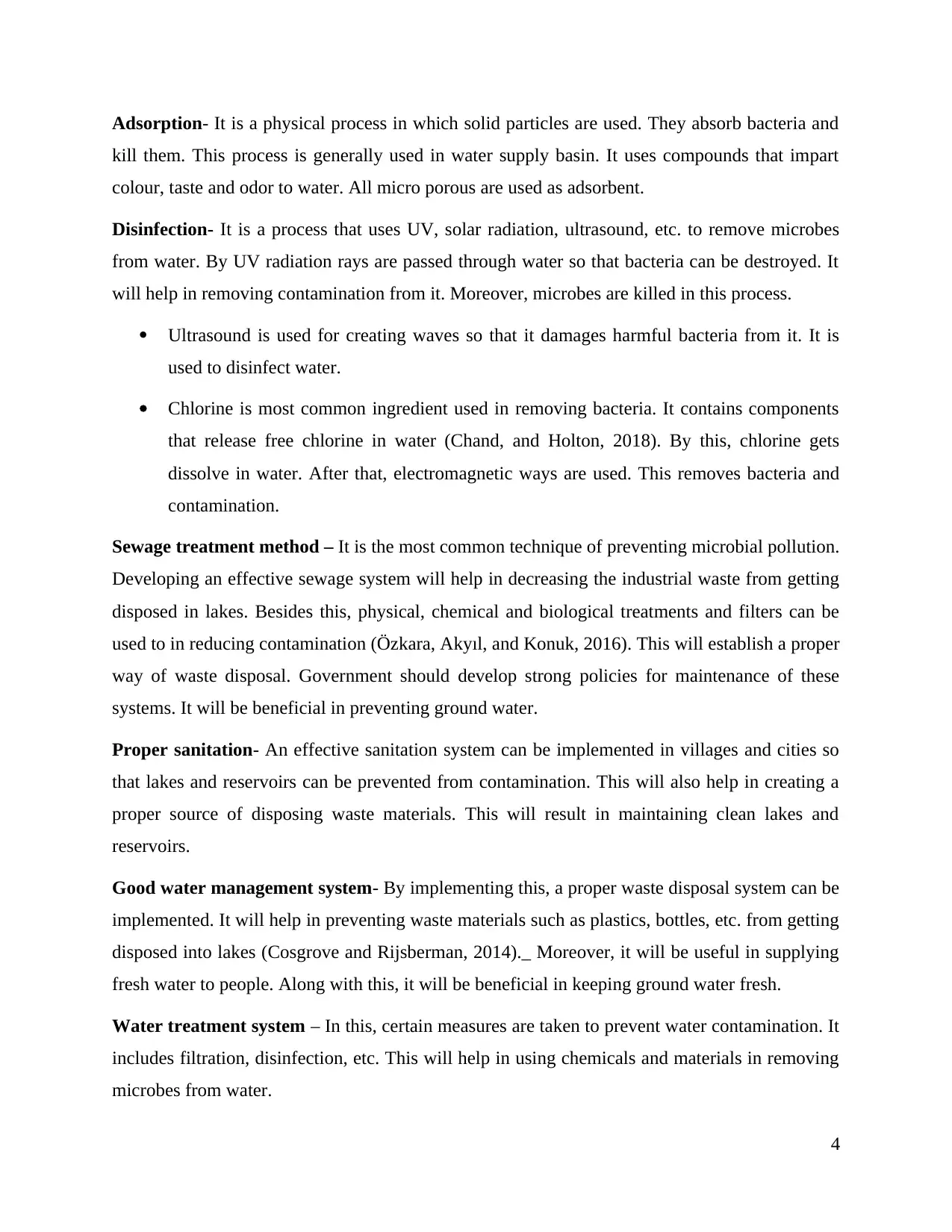
Adsorption- It is a physical process in which solid particles are used. They absorb bacteria and
kill them. This process is generally used in water supply basin. It uses compounds that impart
colour, taste and odor to water. All micro porous are used as adsorbent.
Disinfection- It is a process that uses UV, solar radiation, ultrasound, etc. to remove microbes
from water. By UV radiation rays are passed through water so that bacteria can be destroyed. It
will help in removing contamination from it. Moreover, microbes are killed in this process.
Ultrasound is used for creating waves so that it damages harmful bacteria from it. It is
used to disinfect water.
Chlorine is most common ingredient used in removing bacteria. It contains components
that release free chlorine in water (Chand, and Holton, 2018). By this, chlorine gets
dissolve in water. After that, electromagnetic ways are used. This removes bacteria and
contamination.
Sewage treatment method – It is the most common technique of preventing microbial pollution.
Developing an effective sewage system will help in decreasing the industrial waste from getting
disposed in lakes. Besides this, physical, chemical and biological treatments and filters can be
used to in reducing contamination (Özkara, Akyıl, and Konuk, 2016). This will establish a proper
way of waste disposal. Government should develop strong policies for maintenance of these
systems. It will be beneficial in preventing ground water.
Proper sanitation- An effective sanitation system can be implemented in villages and cities so
that lakes and reservoirs can be prevented from contamination. This will also help in creating a
proper source of disposing waste materials. This will result in maintaining clean lakes and
reservoirs.
Good water management system- By implementing this, a proper waste disposal system can be
implemented. It will help in preventing waste materials such as plastics, bottles, etc. from getting
disposed into lakes (Cosgrove and Rijsberman, 2014)._ Moreover, it will be useful in supplying
fresh water to people. Along with this, it will be beneficial in keeping ground water fresh.
Water treatment system – In this, certain measures are taken to prevent water contamination. It
includes filtration, disinfection, etc. This will help in using chemicals and materials in removing
microbes from water.
4
kill them. This process is generally used in water supply basin. It uses compounds that impart
colour, taste and odor to water. All micro porous are used as adsorbent.
Disinfection- It is a process that uses UV, solar radiation, ultrasound, etc. to remove microbes
from water. By UV radiation rays are passed through water so that bacteria can be destroyed. It
will help in removing contamination from it. Moreover, microbes are killed in this process.
Ultrasound is used for creating waves so that it damages harmful bacteria from it. It is
used to disinfect water.
Chlorine is most common ingredient used in removing bacteria. It contains components
that release free chlorine in water (Chand, and Holton, 2018). By this, chlorine gets
dissolve in water. After that, electromagnetic ways are used. This removes bacteria and
contamination.
Sewage treatment method – It is the most common technique of preventing microbial pollution.
Developing an effective sewage system will help in decreasing the industrial waste from getting
disposed in lakes. Besides this, physical, chemical and biological treatments and filters can be
used to in reducing contamination (Özkara, Akyıl, and Konuk, 2016). This will establish a proper
way of waste disposal. Government should develop strong policies for maintenance of these
systems. It will be beneficial in preventing ground water.
Proper sanitation- An effective sanitation system can be implemented in villages and cities so
that lakes and reservoirs can be prevented from contamination. This will also help in creating a
proper source of disposing waste materials. This will result in maintaining clean lakes and
reservoirs.
Good water management system- By implementing this, a proper waste disposal system can be
implemented. It will help in preventing waste materials such as plastics, bottles, etc. from getting
disposed into lakes (Cosgrove and Rijsberman, 2014)._ Moreover, it will be useful in supplying
fresh water to people. Along with this, it will be beneficial in keeping ground water fresh.
Water treatment system – In this, certain measures are taken to prevent water contamination. It
includes filtration, disinfection, etc. This will help in using chemicals and materials in removing
microbes from water.
4
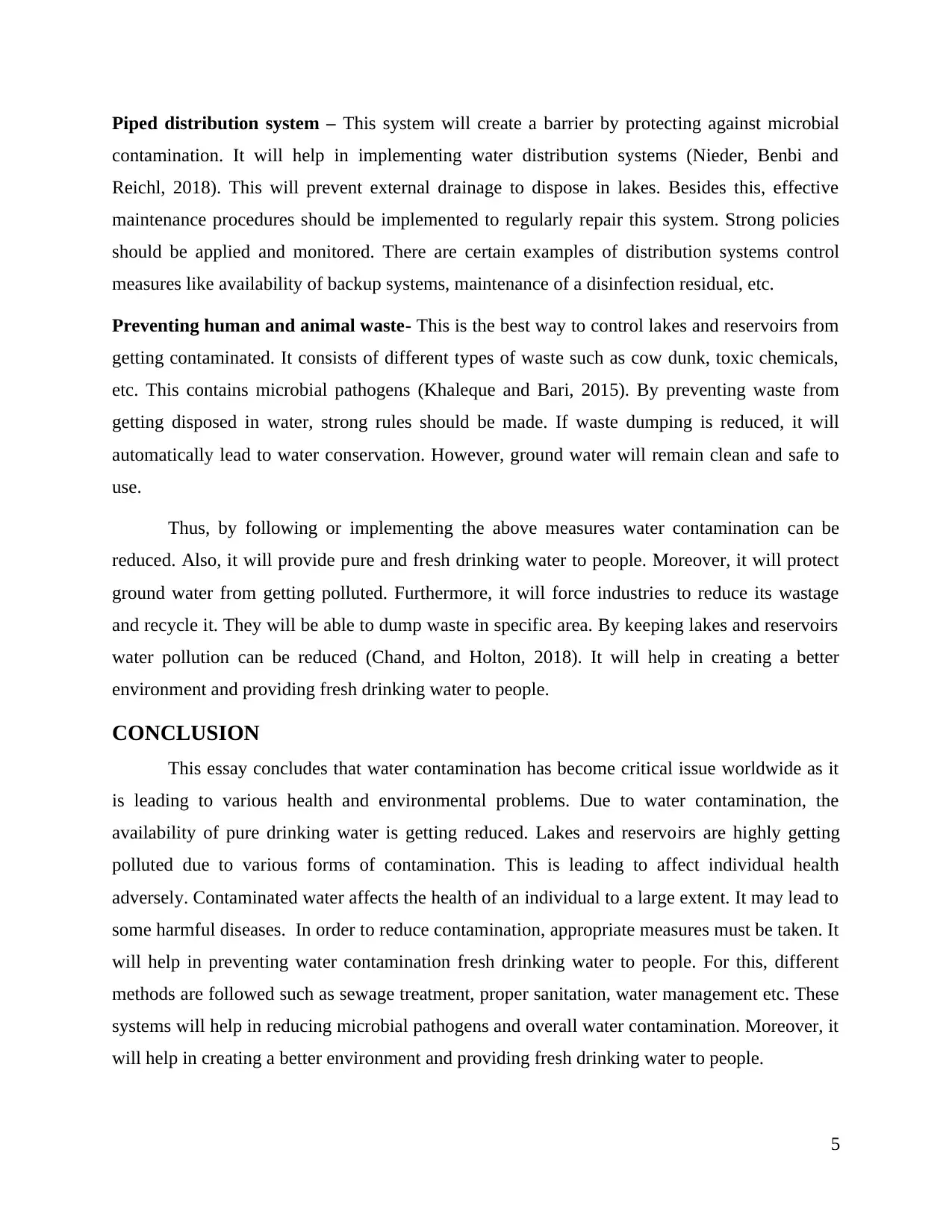
Piped distribution system – This system will create a barrier by protecting against microbial
contamination. It will help in implementing water distribution systems (Nieder, Benbi and
Reichl, 2018). This will prevent external drainage to dispose in lakes. Besides this, effective
maintenance procedures should be implemented to regularly repair this system. Strong policies
should be applied and monitored. There are certain examples of distribution systems control
measures like availability of backup systems, maintenance of a disinfection residual, etc.
Preventing human and animal waste- This is the best way to control lakes and reservoirs from
getting contaminated. It consists of different types of waste such as cow dunk, toxic chemicals,
etc. This contains microbial pathogens (Khaleque and Bari, 2015). By preventing waste from
getting disposed in water, strong rules should be made. If waste dumping is reduced, it will
automatically lead to water conservation. However, ground water will remain clean and safe to
use.
Thus, by following or implementing the above measures water contamination can be
reduced. Also, it will provide pure and fresh drinking water to people. Moreover, it will protect
ground water from getting polluted. Furthermore, it will force industries to reduce its wastage
and recycle it. They will be able to dump waste in specific area. By keeping lakes and reservoirs
water pollution can be reduced (Chand, and Holton, 2018). It will help in creating a better
environment and providing fresh drinking water to people.
CONCLUSION
This essay concludes that water contamination has become critical issue worldwide as it
is leading to various health and environmental problems. Due to water contamination, the
availability of pure drinking water is getting reduced. Lakes and reservoirs are highly getting
polluted due to various forms of contamination. This is leading to affect individual health
adversely. Contaminated water affects the health of an individual to a large extent. It may lead to
some harmful diseases. In order to reduce contamination, appropriate measures must be taken. It
will help in preventing water contamination fresh drinking water to people. For this, different
methods are followed such as sewage treatment, proper sanitation, water management etc. These
systems will help in reducing microbial pathogens and overall water contamination. Moreover, it
will help in creating a better environment and providing fresh drinking water to people.
5
contamination. It will help in implementing water distribution systems (Nieder, Benbi and
Reichl, 2018). This will prevent external drainage to dispose in lakes. Besides this, effective
maintenance procedures should be implemented to regularly repair this system. Strong policies
should be applied and monitored. There are certain examples of distribution systems control
measures like availability of backup systems, maintenance of a disinfection residual, etc.
Preventing human and animal waste- This is the best way to control lakes and reservoirs from
getting contaminated. It consists of different types of waste such as cow dunk, toxic chemicals,
etc. This contains microbial pathogens (Khaleque and Bari, 2015). By preventing waste from
getting disposed in water, strong rules should be made. If waste dumping is reduced, it will
automatically lead to water conservation. However, ground water will remain clean and safe to
use.
Thus, by following or implementing the above measures water contamination can be
reduced. Also, it will provide pure and fresh drinking water to people. Moreover, it will protect
ground water from getting polluted. Furthermore, it will force industries to reduce its wastage
and recycle it. They will be able to dump waste in specific area. By keeping lakes and reservoirs
water pollution can be reduced (Chand, and Holton, 2018). It will help in creating a better
environment and providing fresh drinking water to people.
CONCLUSION
This essay concludes that water contamination has become critical issue worldwide as it
is leading to various health and environmental problems. Due to water contamination, the
availability of pure drinking water is getting reduced. Lakes and reservoirs are highly getting
polluted due to various forms of contamination. This is leading to affect individual health
adversely. Contaminated water affects the health of an individual to a large extent. It may lead to
some harmful diseases. In order to reduce contamination, appropriate measures must be taken. It
will help in preventing water contamination fresh drinking water to people. For this, different
methods are followed such as sewage treatment, proper sanitation, water management etc. These
systems will help in reducing microbial pathogens and overall water contamination. Moreover, it
will help in creating a better environment and providing fresh drinking water to people.
5
Paraphrase This Document
Need a fresh take? Get an instant paraphrase of this document with our AI Paraphraser
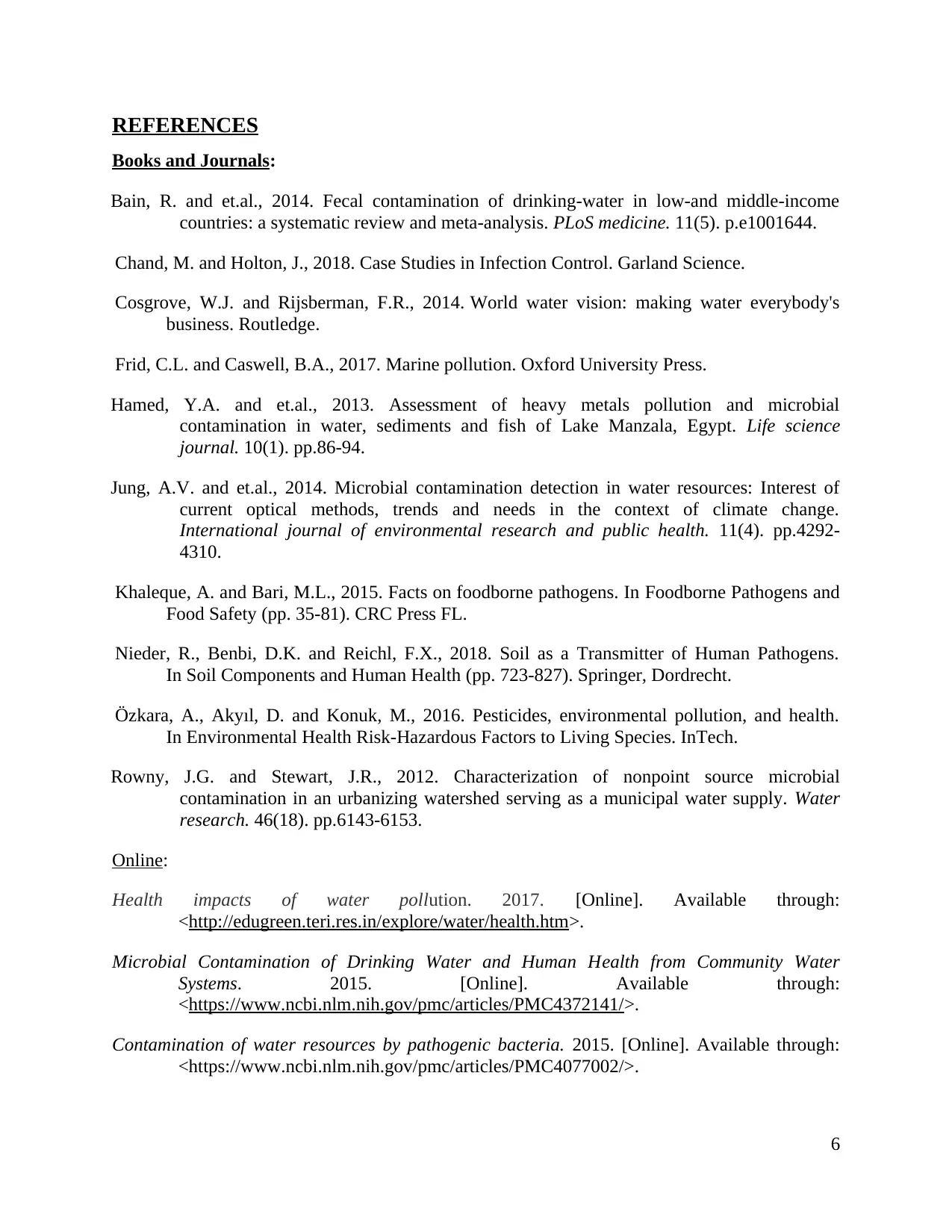
REFERENCES
Books and Journals:
Bain, R. and et.al., 2014. Fecal contamination of drinking-water in low-and middle-income
countries: a systematic review and meta-analysis. PLoS medicine. 11(5). p.e1001644.
Chand, M. and Holton, J., 2018. Case Studies in Infection Control. Garland Science.
Cosgrove, W.J. and Rijsberman, F.R., 2014. World water vision: making water everybody's
business. Routledge.
Frid, C.L. and Caswell, B.A., 2017. Marine pollution. Oxford University Press.
Hamed, Y.A. and et.al., 2013. Assessment of heavy metals pollution and microbial
contamination in water, sediments and fish of Lake Manzala, Egypt. Life science
journal. 10(1). pp.86-94.
Jung, A.V. and et.al., 2014. Microbial contamination detection in water resources: Interest of
current optical methods, trends and needs in the context of climate change.
International journal of environmental research and public health. 11(4). pp.4292-
4310.
Khaleque, A. and Bari, M.L., 2015. Facts on foodborne pathogens. In Foodborne Pathogens and
Food Safety (pp. 35-81). CRC Press FL.
Nieder, R., Benbi, D.K. and Reichl, F.X., 2018. Soil as a Transmitter of Human Pathogens.
In Soil Components and Human Health (pp. 723-827). Springer, Dordrecht.
Özkara, A., Akyıl, D. and Konuk, M., 2016. Pesticides, environmental pollution, and health.
In Environmental Health Risk-Hazardous Factors to Living Species. InTech.
Rowny, J.G. and Stewart, J.R., 2012. Characterization of nonpoint source microbial
contamination in an urbanizing watershed serving as a municipal water supply. Water
research. 46(18). pp.6143-6153.
Online:
Health impacts of water pollution. 2017. [Online]. Available through:
<http://edugreen.teri.res.in/explore/water/health.htm>.
Microbial Contamination of Drinking Water and Human Health from Community Water
Systems. 2015. [Online]. Available through:
<https://www.ncbi.nlm.nih.gov/pmc/articles/PMC4372141/>.
Contamination of water resources by pathogenic bacteria. 2015. [Online]. Available through:
<https://www.ncbi.nlm.nih.gov/pmc/articles/PMC4077002/>.
6
Books and Journals:
Bain, R. and et.al., 2014. Fecal contamination of drinking-water in low-and middle-income
countries: a systematic review and meta-analysis. PLoS medicine. 11(5). p.e1001644.
Chand, M. and Holton, J., 2018. Case Studies in Infection Control. Garland Science.
Cosgrove, W.J. and Rijsberman, F.R., 2014. World water vision: making water everybody's
business. Routledge.
Frid, C.L. and Caswell, B.A., 2017. Marine pollution. Oxford University Press.
Hamed, Y.A. and et.al., 2013. Assessment of heavy metals pollution and microbial
contamination in water, sediments and fish of Lake Manzala, Egypt. Life science
journal. 10(1). pp.86-94.
Jung, A.V. and et.al., 2014. Microbial contamination detection in water resources: Interest of
current optical methods, trends and needs in the context of climate change.
International journal of environmental research and public health. 11(4). pp.4292-
4310.
Khaleque, A. and Bari, M.L., 2015. Facts on foodborne pathogens. In Foodborne Pathogens and
Food Safety (pp. 35-81). CRC Press FL.
Nieder, R., Benbi, D.K. and Reichl, F.X., 2018. Soil as a Transmitter of Human Pathogens.
In Soil Components and Human Health (pp. 723-827). Springer, Dordrecht.
Özkara, A., Akyıl, D. and Konuk, M., 2016. Pesticides, environmental pollution, and health.
In Environmental Health Risk-Hazardous Factors to Living Species. InTech.
Rowny, J.G. and Stewart, J.R., 2012. Characterization of nonpoint source microbial
contamination in an urbanizing watershed serving as a municipal water supply. Water
research. 46(18). pp.6143-6153.
Online:
Health impacts of water pollution. 2017. [Online]. Available through:
<http://edugreen.teri.res.in/explore/water/health.htm>.
Microbial Contamination of Drinking Water and Human Health from Community Water
Systems. 2015. [Online]. Available through:
<https://www.ncbi.nlm.nih.gov/pmc/articles/PMC4372141/>.
Contamination of water resources by pathogenic bacteria. 2015. [Online]. Available through:
<https://www.ncbi.nlm.nih.gov/pmc/articles/PMC4077002/>.
6
1 out of 8
Related Documents
Your All-in-One AI-Powered Toolkit for Academic Success.
+13062052269
info@desklib.com
Available 24*7 on WhatsApp / Email
![[object Object]](/_next/static/media/star-bottom.7253800d.svg)
Unlock your academic potential
© 2024 | Zucol Services PVT LTD | All rights reserved.





